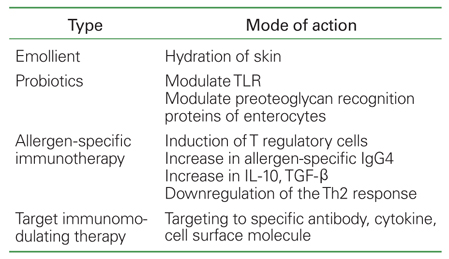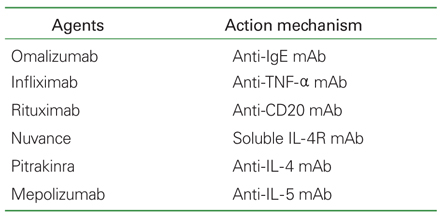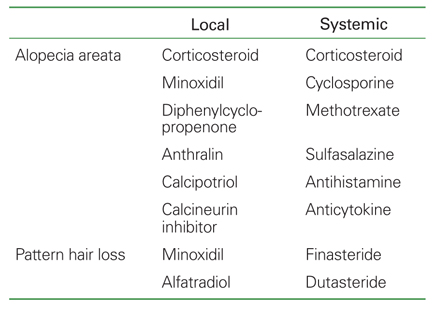 |
 |
- Search
| J Korean Med Assoc > Volume 55(5); 2012 > Article |
Abstract
The number of therapeutic options available to dermatologists for skin disorders has grown significantly over the past several years. Incorporating newly developed and recruited therapeutic modalities into the dermatologic field can promote a better overall treatment outcome and patient satisfaction while reducing common side effect. This article focuses to explore the current and new application of various therapeutic options for skin disorders. In particular, some mechanisms of action behind each therapy will be discussed. It is the hope that through this paper, clinicians will feel more comfortable choosing among these treatment options in their everyday practice of dermatology.
References
1. Bos JD, Van Leent EJ, Sillevis Smitt JH. The millennium criteria for the diagnosis of atopic dermatitis. Exp Dermatol 1998;7:132-138.
2. Elias PM, Hatano Y, Williams ML. Basis for the barrier abnormality in atopic dermatitis: outside-inside-outside pathogenic mechanisms. J Allergy Clin Immunol 2008;121:1337-1343.
3. Weidinger S, O'Sullivan M, Illig T, Baurecht H, Depner M, Rodriguez E, Ruether A, Klopp N, Vogelberg C, Weiland SK, McLean WH, von Mutius E, Irvine AD, Kabesch M. Filaggrin mutations, atopic eczema, hay fever, and asthma in children. J Allergy Clin Immunol 2008;121:1203-1209.e1.
4. Lomax AR, Calder PC. Probiotics, immune function, infection and inflammation: a review of the evidence from studies conducted in humans. Curr Pharm Des 2009;15:1428-1518.
5. Till SJ, Francis JN, Nouri-Aria K, Durham SR. Mechanisms of immunotherapy. J Allergy Clin Immunol 2004;113:1025-1034.
6. Busse W, Corren J, Lanier BQ, McAlary M, Fowler-Taylor A, Cioppa GD, van As A, Gupta N. Omalizumab, anti-IgE recombinant humanized monoclonal antibody, for the treatment of severe allergic asthma. J Allergy Clin Immunol 2001;108:184-190.
7. Scanlon JV, Exter BP, Steinberg M, Jarvis CI. Ustekinumab: treatment of adult moderate-to-severe chronic plaque psoriasis. Ann Pharmacother 2009;43:1456-1465.
8. Schmitt J, Wozel G. Targeted treatment of psoriasis with adalimumab: a critical appraisal based on a systematic review of the literature. Biologics 2009;3:303-318.
9. Gospodarevskaya E, Picot J, Cooper K, Loveman E, Takeda A. Ustekinumab for the treatment of moderate to severe pso-riasis. Health Technol Assess 2009;13:Suppl 3. 61-66.
10. Frankel AJ, Van Voorhees AS, Hsu S, Korman NJ, Lebwohl MG, Bebo BF Jr, Gottlieb AB. National Psoriasis Foundation. Treatment of psoriasis in patients with hepatitis C: from the Medical Board of the National Psoriasis Foundation. J Am Acad Dermatol 2009;61:1044-1055.
11. Bergasa NV, McGee M, Ginsburg IH, Engler D. Gabapentin in patients with the pruritus of cholestasis: a double-blind, randomized, placebo-controlled trial. Hepatology 2006;44:1317-1323.
12. Zylicz Z, Krajnik M, Sorge AA, Costantini M. Paroxetine in the treatment of severe non-dermatological pruritus: a randomized, controlled trial. J Pain Symptom Manage 2003;26:1105-1112.
13. Muhlemann MF, Carter GD, Cream JJ, Wise P. Oral spironolactone: an effective treatment for acne vulgaris in women. Br J Dermatol 1986;115:227-232.
14. Taylor MN, Gonzalez ML. The practicalities of photodynamic therapy in acne vulgaris. Br J Dermatol 2009;160:1140-1148.
15. Massing AM, Epstein WL. Natural history of warts. A two-year study. Arch Dermatol 1963;87:306-310.
16. Morton CA, McKenna KE, Rhodes LE. British Association of Dermatologists Therapy Guidelines and Audit Subcommittee and the British Photodermatology Group. Guidelines for topical photodynamic therapy: update. Br J Dermatol 2008;159:1245-1266.
17. Robson KJ, Cunningham NM, Kruzan KL, Patel DS, Kreiter CD, O'Donnell MJ, Arpey CJ. Pulsed-dye laser versus conven-tional therapy in the treatment of warts: a prospective ran-domized trial. J Am Acad Dermatol 2000;43(2 Pt 1):275-280.
18. Micali G, Dall'Oglio F, Nasca MR, Tedeschi A. Management of cutaneous warts: an evidence-based approach. Am J Clin Dermatol 2004;5:311-317.
19. Hood R, Shermock KM, Emerman C. A prospective, randomized pilot evaluation of topical triple antibiotic versus mupirocin for the prevention of uncomplicated soft tissue wound infection. Am J Emerg Med 2004;22:1-3.
20. Garg S, Messenger AG. Alopecia areata: evidence-based treatments. Semin Cutan Med Surg 2009;28:15-18.
21. Shaheedi-Dadras M, Karami A, Mollaei F, Moravvej H, Malekzad F. The effect of methylprednisolone pulse-therapy plus oral cyclosporine in the treatment of alopecia totalis and universalis. Arch Iran Med 2008;11:90-93.
22. Ito T, Aoshima M, Ito N, Uchiyama I, Sakamoto K, Kawamura T, Yagi H, Hashizume H, Takigawa M. Combination therapy with oral PUVA and corticosteroid for recalcitrant alopecia areata. Arch Dermatol Res 2009;301:373-380.
23. Bikle DD, Elalieh H, Chang S, Xie Z, Sundberg JP. Development and progression of alopecia in the vitamin D receptor null mouse. J Cell Physiol 2006;207:340-353.
24. Sauerbrey A. Successful immunsuppression in childhood alopecia areata. Klin Padiatr 2011;223:244-245.
25. Inui S, Nakajima T, Toda N, Itami S. Fexofenadine hydrochloride enhances the efficacy of contact immunotherapy for extensive alopecia areata: Retrospective analysis of 121 cases. J Dermatol 2009;36:323-327.
26. Ohyama M, Shimizu A, Tanaka K, Amagai M. Experimental evaluation of ebastine, a second-generation anti-histamine, as a supportive medication for alopecia areata. J Dermatol Sci 2010;58:154-157.
27. Skurkovich S, Korotky NG, Sharova NM, Skurkovich B. Treatment of alopecia areata with anti-interferon-gamma antibodies. J Investig Dermatol Symp Proc 2005;10:283-284.
28. Lee WS, Ro BI, Hong SP, Bak H, Sim WY, Kim do W, Park JK, Ihm CW, Eun HC, Kwon OS, Choi GS, Kye YC, Yoon TY, Kim SJ, Kim HO, Kang H, Goo J, Ahn SY, Kim M, Jeon SY, Oh TH. A new classification of pattern hair loss that is universal for men and women: basic and specific (BASP) classification. J Am Acad Dermatol 2007;57:37-46.
29. Mounsey AL, Reed SW. Diagnosing and treating hair loss. Am Fam Physician 2009;80:356-362.
30. Patel SP, Woodman SE. Profile of ipilimumab and its role in the treatment of metastatic melanoma. Drug Des Devel Ther 2011;5:489-495.
31. Alcala AM, Flaherty KT. BRAF inhibitors for the treatment of metastatic melanoma: clinical trials and mechanisms of resistance. Clin Cancer Res 2012;18:33-39.
32. Suzuki D, Kobayashi R, Yasuda K, Yamamoto H, Morioka K, Mikawa M, Kobayashi K. Congenital dermatofibrosarcoma protuberans in a newborn infant with a massive back tumor: favorable effects of oral imatinib on the control of residual tumor growth. J Pediatr Hematol Oncol 2011;33:e304-e306.
Figure 1
Basic and specific pattern classification (From Lee WS, et al. J Am Acad Dermatol 2007;57:37-46) [28].

- TOOLS
-
METRICS

-
- 1 Crossref
- Scopus
- 1,513 View
- 2 Download
-
Related articles in
J Korean Med Assoc -
Recently Identified Hepatitis Viruses1998 March;41(3)
Recent Development of Radiation Therapy for Breast Cancer2009 October;52(10)
Evidence-based pharmacotherapy for panic disorder2010 October;53(10)
Current update of therapeutic interventions for stroke rehabilitation2013 January;56(1)
Recent advances in pediatric hemato-oncologic disease2016 September;59(9)








